Henny Penny OFE-341, OFE-342, OEA-341, OEA-342, OFG-341 User Manual
...
Henny Penny
High Volume Open Fryer
Model OFE/OFG-341
Model OFE/OFG-342
Model OEA/OGA-341
Model OEA/OGA-342
TECHNICAL MANUAL

Model OFE/OFG/OEA/OGA-341, 342
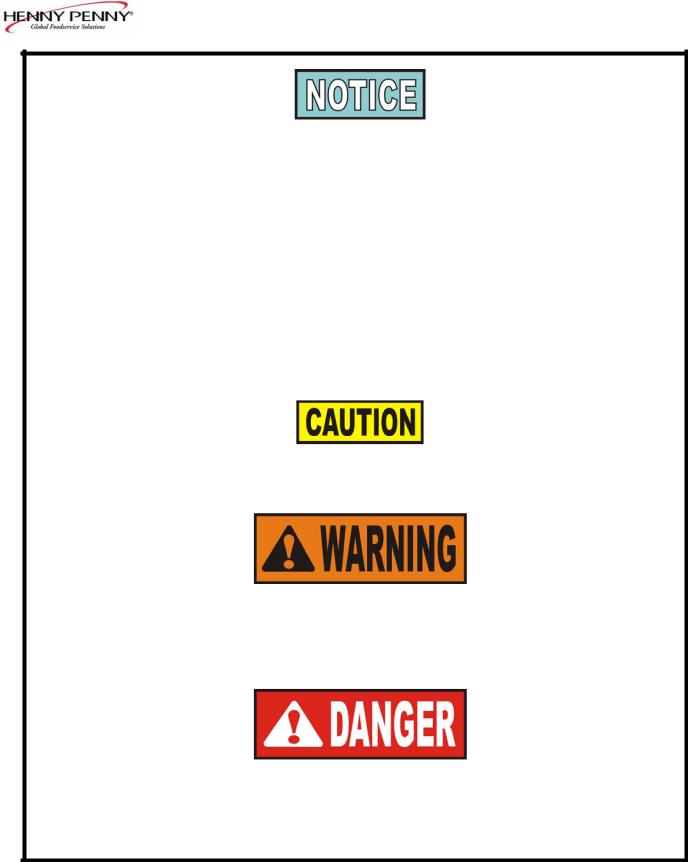
Model OFE/OFG/OEA/OGA-341, 342
This manual should be retained in a convenient location for future reference.
A wiring diagram for this appliance is located on the inside of the right side panel.
Post in a prominent location, instructions to be followed in event user smells gas. This information shall be obtained by consulting the local gas supplier.
Do not obstruct the flow of combustion and ventilation air. Adequate clearance must be left all around appliance for sufficient air to the combustion chamber.
The Model OFG/OGA-34X open fryer is equipped with a continuous pilot. But the open fryer can not be operated without electric power. The unit will automatically return to normal operation when power is restored.
To avoid a fire, keep appliance area free and clear from combustibles.
Improper installation, adjustment, alteration, service or maintenance can cause property damage, injury or death. Read the installation, operating and maintenance instructions thoroughly before installing or servicing this equipment.
FOR YOUR SAFETY, DO NOT STORE OR USE GASOLINE OR OTHER FLAMMABLE VAPORS AND LIQUIDS IN THE VICINITY OF THIS OR ANY OTHER APPLIANCE.
FM06-030
Revised 12-30-09

|
Model OFE/OFG/OEA/OGA-341, 342 |
|
|
TABLE OF CONTENTS |
|
Section |
|
Page |
Section 1. TROUBLESHOOTING................................................................................................... |
1-1 |
|
1-1. |
Introduction............................................................................................................. |
1-1 |
1-2. |
Safety ...................................................................................................................... |
1-1 |
1-3. |
Troubleshooting ...................................................................................................... |
1-2 |
1-4. |
Error Codes ............................................................................................................. |
1-4 |
Section 2. MAINTENANCE ............................................................................................................. |
2-1 |
|
2-1. |
Introduction............................................................................................................. |
2-1 |
2-2. |
Maintenance Hints .................................................................................................. |
2-1 |
2-3. |
High Temperature Limit Control (Gas Units) ........................................................ |
2-1 |
2-4. |
Complete Control Panel Replacement ................................................................... |
2-4 |
2-5. |
Power Switch .......................................................................................................... |
2-4 |
2-6. |
Temperature Probe Replacement (Gas).................................................................. |
2-5 |
2-7. |
Temperature Probe Replacement (Electric)............................................................ |
2-6 |
2-8. |
Flame Sensor/Pilot/Ignitor Assembly (Gas) ........................................................... |
2-7 |
2-9. |
Ignition Module ...................................................................................................... |
2-9 |
2-10. |
Transformer Replacement....................................................................................... |
2-10 |
2-11. |
Control & I/O Boards Replacement........................................................................ |
2-10 |
2-12. |
Vacuum Switch Replacement ................................................................................. |
2-11 |
2-13. |
Drain Microswitch Replacement ............................................................................ |
2-12 |
2-14. |
Filter Switch Replacement...................................................................................... |
2-12 |
2-15. |
Gas Control Valve Replacement............................................................................. |
2-13 |
2-16. |
Blower Motor Replacement.................................................................................... |
2-15 |
2-17. |
Heating Elements (Electric).................................................................................... |
2-17 |
2-18. |
Heating Contactors (Electric) ................................................................................. |
2-19 |
2-19. |
Speaker Assembly................................................................................................... |
2-22 |
2-20. |
High Temperature Limit Control (Electric)............................................................ |
2-23 |
2-21. |
Filter Pump and Motor Removal ............................................................................ |
2-26 |
2-22. |
Autolift Transformer Replacement (if applicable) ................................................. |
2-27 |
2-23. |
Autolift PC Board Replacement (if applicable)...................................................... |
2-28 |
2-24. |
Autolift Actuator (Motor) Replacement (if applicable).......................................... |
2-28 |
|
Wiring Diagrams |
|
Section 3. PARTS INFORMATION ................................................................................................. |
3-1 |
|
3-1. |
Introduction............................................................................................................. |
3-1 |
3-2. |
Genuine Parts.......................................................................................................... |
3-1 |
3-3. |
When Ordering Parts............................................................................................... |
3-1 |
3-4. |
Prices....................................................................................................................... |
3-1 |
3-5. |
Delivery .................................................................................................................. |
3-1 |
3-6. |
Warranty ................................................................................................................. |
3-1 |
3-7. |
Recommended Spare Parts for Distributors............................................................ |
3-1 |
ii |
|
106 |

|
|
Model OFE/OFG/OEA/OGA-341, 342 |
|
|
|
|
|
SECTION 1. TROUBLESHOOTING |
|
|
|
1-1. INTRODUCTION |
This section provides troubleshooting information in the form of |
|
|
|
an easy to read table. |
|
|
If a problem occurs during the first operation of a new fryer, |
|
|
recheck the Installation Section of the Operator’s Manual. |
|
|
Before troubleshooting, always recheck the Operation Section of |
|
|
the Operator’s Manual. |
1-2. SAFETY |
Where information is of particular importance or is safety related, |
|
|
|
the words DANGER, WARNING, CAUTION, or NOTE are used. |
|
|
Their usage is described on the next page: |
|
|
SAFETY ALERT SYMBOL is used with DANGER, |
|
|
WARNING or CAUTION which indicates a personal |
|
|
injury type hazard. |
|
|
NOTICE is used to highlight especially important |
|
|
information. |
|
|
CAUTION used without the safety alert symbol indicates a |
|
|
potentially hazardous situation which, if not avoided, may |
|
|
result in property damage. |
|
|
CAUTION used with the safety alert symbol indicates a |
|
|
potentially hazardous situation which, if not avoided, |
|
|
could result in minor or moderate injury. |
|
|
WARNING indicates a potentially hazardous situation |
|
|
which, if not avoided, could result in death or serious |
|
|
injury. |
DANGER INDICATES AN IMMINENTLY
HAZARDOUS SITUATION WHICH, IF NOT
AVOIDED, WILL RESULT IN DEATH OR
SERIOUS INJURY.
1003 |
1-1 |
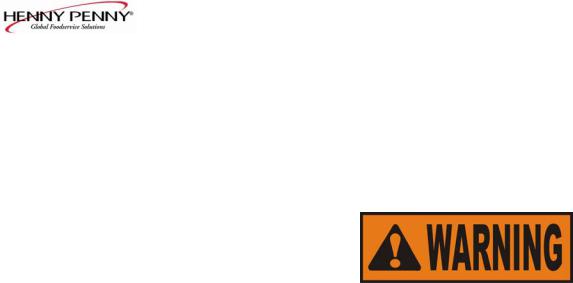
|
|
|
Model OFE/OFG/OEA/OGA-341, 342 |
|
1-3. TROUBLESHOOTING |
To isolate a malfunction, proceed as follows: |
|||
|
|
1. Clearly define the problem or symptom and when it |
||
|
|
occurs. |
|
|
|
|
2. Locate the problem in the Troubleshooting table. |
||
|
|
3. Review all possible causes, then one at a time work |
||
|
|
through the list of corrections until the problem is solved. |
||
|
|
If maintenance procedures are not followed correctly, |
||
|
|
injuries and/or property damage could result. |
||
|
|
|
|
|
|
PROBLEM |
CAUSE |
CORRECTION |
|
|
|
|
|
|
|
With the switch in |
• Open circuit |
• Check to see if unit is plugged in |
|
|
the ON position, |
|
• Check breaker or fuse at supply box |
|
|
fryer is completely |
|
||
|
inoperative |
|
• Check power switch per Power Switch |
|
|
|
|
||
|
|
|
Section; replace if defective |
|
|
|
|
• Check voltage at wall receptacle |
|
|
|
|
• Check cord and plug |
|
|
|
|
|
|
|
Shortening will not |
• Faulty contactor |
• Check contactor per Heating Contactors |
|
|
heat but lights are on |
(elec. model) |
Section |
|
|
|
• Faulty gas control |
• Check gas control valve per Gas Control |
|
|
|
valve (gas model) |
Valve Assembly Section |
|
|
|
• Faulty temperature |
• Check temperature probe per Temperature |
|
|
|
probe |
Probe Replacement Section; “E6” |
|
|
|
• Faulty high limit |
• Check high limit per the appropriate High |
|
|
|
|
Temperature Limit Control Section; “E10” |
|
|
|
• Faulty drain switch |
• Check drain switch per Drain Microswitch |
|
|
|
|
Section; “E15" |
|
|
|
|
||
1-2 |
|
1003 |
||

|
|
|
|
Model OFE/OFG/OEA/OGA-341, 342 |
|
1-3. TROUBLESHOOTING(Continued) |
|
|
|||
|
|
|
|
|
|
|
|
PROBLEM |
CAUSE |
CORRECTION |
|
|
|
|
|
|
|
|
|
Heating of |
• Low or improper |
• Use a meter and check the receptacle |
|
|
|
shortening too |
voltage (elec. unit) |
voltage against the data plate |
|
|
|
slow |
• Weak or burnt out |
• Check heating elements per Heating |
|
|
|
|
|||
|
|
|
elements (elec. unit) |
Elements Section |
|
|
|
|
• Wire(s) loose |
• Tighten |
|
|
|
|
• Burnt or charred |
• Replace wire and clean connectors |
|
|
|
|
wire connection |
|
|
|
|
|
• Faulty contactor |
• Check contactor per Heating Contactors |
|
|
|
|
|
Section |
|
|
|
|
• Supply line too small |
• Increase supply line size; refer to |
|
|
|
|
- low gas volume (gas |
Installation Section of Operator’s Manual |
|
|
|
|
unit) |
|
|
|
|
|
• Improper ventilation |
• Refer to Installation Section of Operator’s |
|
|
|
|
|
Manual |
|
|
|
|
|
|
|
|
|
Shortening |
• Temperature probe |
• Calibrate temperature probe if ± 10° off; |
|
|
|
overheating |
needs calibrated |
if more than ± 10° off, replace temperature |
|
|
|
|
|
probe |
|
|
|
|
• Mercury contactor |
• Check mercury contactor for not opening; |
|
|
|
|
stuck closed |
replace if necessary (elec. unit) |
|
|
|
|
• Bad control board |
• Replace control board if heat indicator stays |
|
|
|
|
|
on past ready temperature |
|
|
|
|
|
|
|
|
|
Foaming or boiling |
• Water in shortening |
• At end of cook cycle, drain shortening and |
|
|
|
over of shortening |
|
clean |
|
|
|
|
• Improper or bad |
• Use recommended shortening |
|
|
|
|
shortening |
|
|
|
|
|
• Improper filtering |
• Refer to the Filtering the Shortening |
|
|
|
|
|
Section in Operator’s Manual |
|
|
|
|
• Improper rinsing after |
• Clean and rinse the frypot; then dry |
|
|
|
|
cleaning the fryer |
thoroughly |
|
1003 |
|
1-3 |
|||
|
|||||

|
|
|
Model OFE/OFG/OEA/OGA-341, 342 |
1-2. TROUBLESHOOTING |
|
|
|
|
(Continued) |
|
|
|
|
|
|
|
PROBLEM |
CAUSE |
CORRECTION |
|
|
|
|
|
Shortening will not |
• Drain valve clogged |
• Open valve, force cleaning brush through |
|
drain from frypot |
with crumbs |
drain |
|
|
• Drain valve will not |
• Replace cotter pins in valve coupling |
|
|
open by turning |
|
|
|
handle |
|
|
|
|
|
|
Filter motor runs |
• Pump clogged |
• Remove pump cover and clean |
|
but pumps shortening |
• Filter line connection |
• Tighten all filter line connections |
|
slowly |
||
|
|
loose |
|
|
|
• Solidified shortening |
• Clear all filter lines of solidified shortening |
|
|
in lines |
|
|
|
|
|
|
Filter switch on, |
• Defective switch |
• Check/replace switch per Filter Switch |
|
motor does not run |
|
Section |
|
|
• Defective motor |
• Check/replace motor |
|
|
• Motor thermal |
• Reset thermal switch on filter motor |
|
|
protector tripped |
|
|
|
|
|
|
Motor hums but |
• Clogged lines or |
• Remove and clean pump and lines |
|
will not pump |
pump |
• Replace pump seal, rotor and rollers |
|
|
|
|
|
|
|
|
1-4 |
1003 |

|
|
|
|
Model OFE/OFG/OEA/OGA-341, 342 |
|
1-4. ERROR CODES |
In the event of a control system failure, the digital display shows |
||||
|
|
|
An error message. These messages are coded: “E4”, “E5”, “E6”, |
||
|
|
|
“E10”, “E15”, “E20”, “E31”, “E41”, “E46”, and “E92”. A |
||
|
|
|
Constant tone is heard when an error code is displayed, and to |
||
|
|
|
silence this tone, press any button. |
||
|
|
|
|
|
|
|
DISPLAY |
CAUSE |
|
PANEL BOARD CORRECTION |
|
|
|
|
|
|
|
|
“E4” |
Control board |
|
Turn switch to OFF position, then turn switch back to ON; |
|
|
|
overheating |
|
if display shows “E4”, the control board is getting too hot; |
|
|
|
|
|
check the louvers on each side of the unit for obstructions |
|
|
|
|
|
|
|
|
“E5” |
Shortening |
|
Turn switch to OFF position, then turn switch back to ON; |
|
|
|
overheating |
|
if display shows “E5”, the heating circuits and temperature |
|
|
|
|
|
probe should be checked |
|
|
“E6-A” |
Temperature |
|
Turn switch to OFF position, then turn switch back to ON; |
|
|
|
probe open |
|
if display shows “E6” the temperature probe should be |
|
|
|
|
|
checked |
|
|
“E6-B” |
Temperature |
|
Turn switch to OFF position, then turn switch back to ON; |
|
|
|
probe shorted |
|
if display shows “E6” the temperature probe should be |
|
|
|
|
|
checked to replace, per Temperature Probe Replacement |
|
|
|
|
|
Section |
|
|
|
|
|
|
|
|
“E10” |
High limit |
|
Reset the high limit by manually pushing up on the red |
|
|
|
|
|
reset button; if high limit does not reset, high limit must be |
|
|
|
|
|
replaced per High Limit Temperature Control Section |
|
|
|
|
|
|
|
|
“E15” |
Drain switch |
|
Close drain, using the drain valve handle; if display still |
|
|
|
failure |
|
shows “E-15”, check the drain microswitch per Drain |
|
|
|
|
|
Microswitch Section |
|
|
|
|
|
|
|
|
“E31” |
Elements not |
|
Check to make sure the elements are hinged all way down |
|
|
|
hinged all the |
|
into the frypot; check for obstructions under elements |
|
|
|
way down |
|
|
|
|
|
|
|
|
|
|
“E41”, |
Programming |
|
Turn switch to OFF, then back to ON; if display shows any |
|
|
“E46” |
failure |
|
of the error codes, try to reinitialize the control (Special |
|
|
|
|
|
Program Mode Section of Operator’s Manual); if error |
|
|
|
|
|
code persists, replace the control panel per Complete |
|
|
|
|
|
Control Panel Replacement Section |
|
|
|
|
|
|
|
|
|
|
|
|
|
1003 |
1-5 |

|
|
|
|
Model OFE/OFG/OEA/OGA-341, 342 |
||
1-4. ERROR CODES |
|
|
|
|||
|
(Continued) |
|
|
|
|
|
|
|
|
|
|
|
|
|
DISPLAY |
|
CAUSE |
PANEL BOARD CORRECTION |
|
|
|
“E-20 A” |
|
Vacuum |
Press the timer button to try the ignition process again, |
||
|
|
|
switch failure |
and if “E-20 A” persists, check the air switch per Vacuum |
||
|
|
|
(stuck closed) |
Switch Section |
|
|
|
|
|
|
|
|
|
|
“E-20 B” |
|
Draft fan or |
Press the timer button to try the ignition process again, |
||
|
|
|
vacuum |
and if “E-20 B” persists, check the vacuum switch per |
||
|
|
|
switch failure |
Vacuum Switch Section or the blower motor per Blower |
||
|
|
|
(stuck open) |
Motor Assembly Section |
|
|
|
|
|
|
|
|
|
|
“E-20 C” |
|
Ignition modules |
Press the timer button to try the ignition process again; if |
||
|
|
|
not responding |
“E-20 C” persists, check the ignition module per Ignitor |
||
|
|
|
|
Module Section, the spark ignitor per Pilot/Ignitor |
||
|
|
|
|
Assembly Section, or the I/O board per Control & I/O |
||
|
|
|
|
Boards Section |
|
|
|
|
|
|
|
|
|
|
“E-20 D” |
|
Pilots not lit or |
Press the timer button to try the ignition process again; if |
||
|
|
|
no flame sense |
“E-20 D” persists, check the ignition module per Ignition |
||
|
|
|
|
Module Section, the I/O board per Control & I/O Boards |
||
|
|
|
|
Section, or the flame sensor per Flame Sensor Section |
||
|
|
|
|
|
|
|
|
“E-47” |
|
Analog converter |
Turn switch to OFF, then back to ON; |
if “E47” persists, |
|
|
|
|
chip or 12 volt |
replace the I/O board, or the PC board; |
if speaker |
|
|
|
|
supply failure |
tones are quiet, probably I/O board failure |
||
|
|
|
|
|
|
|
|
“E-48” |
|
Input system |
Replace PC board |
|
|
|
|
|
error |
|
|
|
|
|
|
|
|
|
|
|
“E-70” |
|
Faulty power |
Check power switch, along with its wiring; |
||
|
|
|
switch or switch |
replace I/O board if necessary |
|
|
|
|
|
wiring; faulty I/O |
|
|
|
|
|
|
board |
|
|
|
|
|
|
|
|
|
|
|
“E-92” |
|
24 VAC fuse |
Check for shorted component in 24 volt circuit; |
||
|
|
|
on I/O open |
(i.e., high limit, drain switch, vacuum switch) |
||
|
|
|
|
|
|
|
|
|
|
|
|
|
|
1-6 |
1003 |
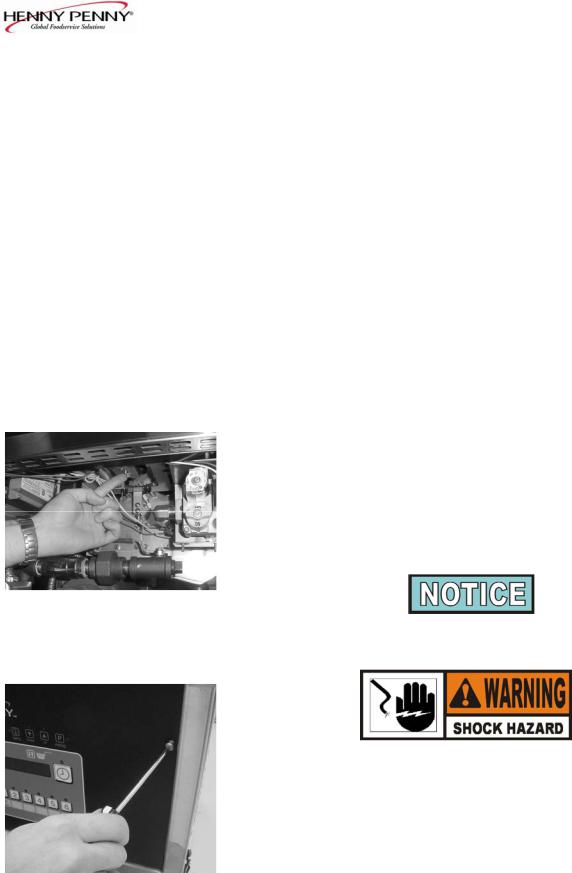
|
|
|
Model OFE/OFG/OEA/OGA-341, 342 |
|
|
|
|
|
|
SECTION 2. MAINTENANCE |
|
|
|
|
|
2-1. INTRODUCTION |
This section provides procedures for the check out and |
||
|
|
|
replacement of the various parts used within the fryer. Before |
|
|
|
replacing any parts refer to the Troubleshooting Section. It will aid |
|
|
|
you in determining the cause of the malfunction. |
2-2. |
MAINTENANCE HINTS |
1. You may need to use a multimeter to check the electric |
|
|
|
|
components. |
|
|
|
2. When the manual refers to the circuit being closed, the |
|
|
|
multimeter should read zero unless otherwise noted. |
|
|
|
3. When the manual refers to the circuit being open, the |
|
|
|
multimeter will read infinity. |
2-3. |
HIGH TEMPERATURE |
|
|
|
|
LIMIT CONTROL |
This high temperature control is a safety, manual reset control, |
|
|
(Gas Units) |
which senses the temperature of the shortening. If the short- |
|
|
|
ening temperature exceeds 425°F (218°C), this switch opens |
and shuts off heat to the frypot. When the temperature of the shortening drops to a safe operation limit, the control must be manually reset by pressing the red reset button. The red reset button is located under the control panel, in the front of the fryer. (Figure 2-1). This allows heat to be supplied to the frypot.
Before replacing a high temperature limit control, check to see that its circuit is closed.
Figure 2-1
The shortening temperature must be below 380°F (193°C)
to accurately perform this check.
Checkout
To avoid electrical shock or property damage, move the power switch to OFF and disconnect main circuit
breaker, or unplug cord at wall receptacle.
1. Remove the control panel. Figure 2-2.
Figure 2-2
1003 |
2-1 |

Model OFE/OFG/OEA/OGA-341, 342
1-3. HIGH TEMPERATURE 2. Using a Phillip’s head screwdriver, remove the screws securing LIMIT CONTROL the inner heat shield and remove from unit. Figure 2-3.
(Gas Units) (Continued)
Figure 2-3 |
3. Remove the screw securing the high limit bracket to the frame |
|
and remove the high limit and bracket from unit. Figure 2-4. |
Figure 2-4 |
4. Remove the two screws securing the high limit to the bracket |
|
and remove the high limit from bracket. |
5.Remove the two electrical wires from the high temperature limit control. Figure 2-5.
Figure 2-5
6.Manually reset the control, then check for continuity between the two terminals after resetting the control. If the circuit is open, replace the control, then continue with this procedure. (If the circuit is closed, the high limit is not defective. Reconnect the two electrical wires.)
2-2 |
1003 |
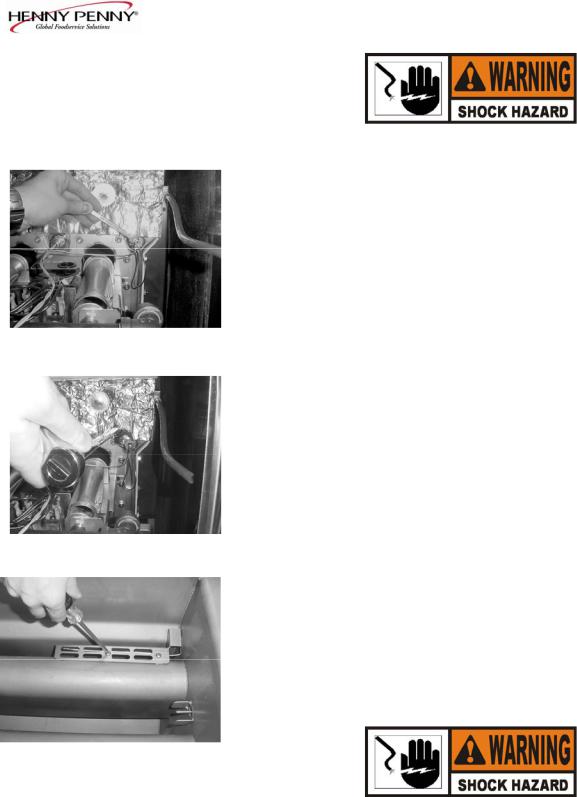
|
|
Model OFE/OFG/OEA/OGA-341, 342 |
2-3. HIGH TEMPERATURE |
|
|
LIMIT CONTROL |
|
|
(Gas Units) (Continued) |
|
|
Replacement |
|
To avoid electrical shock or property damage, move the |
|
|
power switch to OFF and disconnect main circuit |
|
|
breaker, or unplug cord at wall receptacle. |
|
1. |
If the tube is broken or cracked, the control opens, shutting |
|
|
off electrical power to the heat circuit. The control cannot be |
|
|
reset, and it continuously clicks when pushed. |
|
2. |
Drain the shortening from the frypot and discard. A substance |
|
|
from the tube could contaminate the shortening. |
Figure 2-6 |
3. |
Remove the control panel. |
|
4. |
Using a 5/16” wrench, loosen small inside screw nut on |
|
|
capillary tube. Figure 2-6. |
|
5. |
Using a 11/16” crows-foot, remove the larger nut securing the |
|
|
capillary tube to the pot. Figure 2-7. |
Figure 2-7 |
6. |
Remove the two screws securing the high limit guard and |
|
remove guard. Figure 2-8 |
|
|
7. |
Straighten the capillary tube inside the frypot, and pull the |
|
|
capillary tube through the frypot, from behind the control |
|
|
panel. Remove the defective high limit from the control panel |
|
|
area. |
|
8. |
Replace new high limit in reverse order. |
Figure 2-8 |
|
|
|
|
To avoid electrical shock or other injury, run the |
|
|
capillary line under and away from all electrical power |
|
|
wires and terminals. The tube must never be in such a |
|
|
position where it could accidentally touch the electrical |
|
|
power terminals. |
1003 |
|
2-3 |
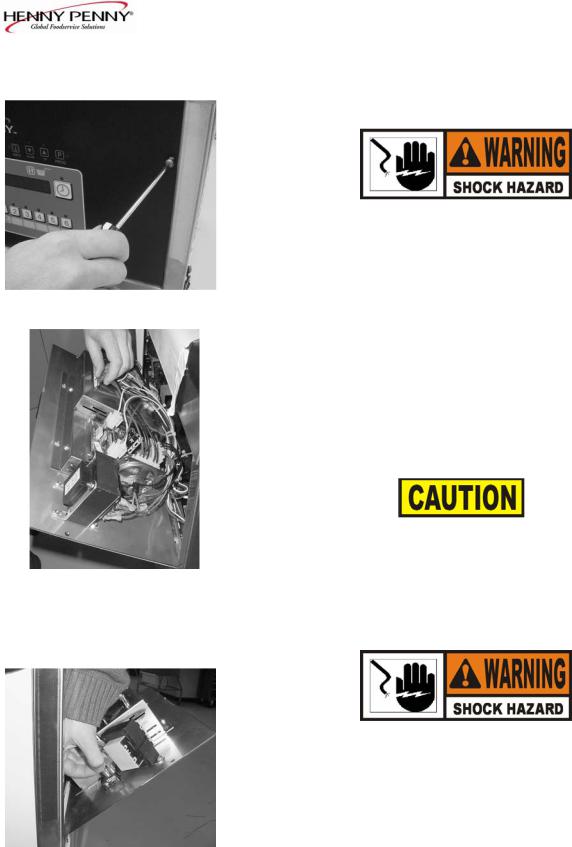
|
|
Model OFE/OFG/OEA/OGA-341, 342 |
2-4. COMPLETE CONTROL |
Should the control board become inoperative, follow these |
|
PANEL REPLACEMENT |
instructions for replacing the board. |
|
|
1. |
Remove electrical power supplied to the unit. |
|
|
To avoid electrical shock or property damage, move the |
|
|
power switch to OFF and disconnect main circuit |
|
|
breaker, or unplug cord at wall receptacle. |
Figure 2-9 |
2. |
Remove the two screws securing the control panel and lift out. |
|
Figure 2-9. |
|
|
3. |
Unplug the wire connectors going to the control panel. |
|
|
Figure 2-10. |
|
4. |
Remove transformer(s) from control panel. They must be |
|
|
installed on the replacement panels. |
|
5. |
Install new control panel in reverse order. |
|
|
When plugging connectors onto new control panel, be sure the |
|
|
connectors are inserted onto all of the pins, and that the |
Figure 2-10 |
|
connectors are not forced onto the pins backwards. If not |
|
connected properly, damage to the board could result. |
|
2-5. POWER SWITCH |
1. |
Remove electrical power supplied to fryer. |
|
|
To avoid electrical shock or property damage, move the |
|
|
power switch to OFF and disconnect main circuit |
|
|
breaker, or unplug cord at wall receptacle. |
|
2. |
Remove control panel. |
Figure 2-11 |
3. |
Label and remove wires from the switch. With test instrument |
|
check across the terminals of the switch with switch in the on |
|
|
|
position, and the circuit should be closed. In the off position, |
|
|
the circuit should be open. If the switch checks defective, |
|
|
replace by continuing with this procedure. Figure 2-11. |
2-4 |
|
504 |
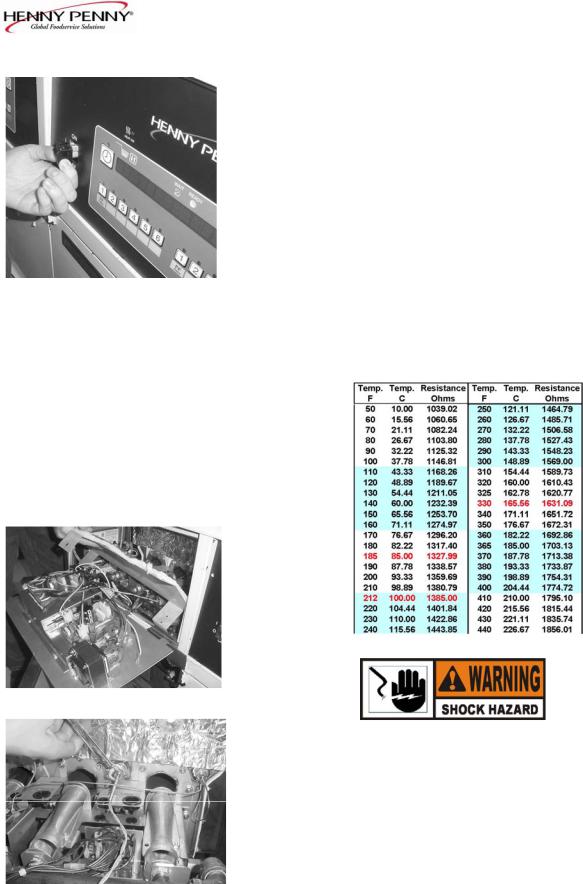
Model OFE/OFG/OEA/OGA-341, 342
2-5. POWER SWITCH (Continued)
4.With control panel removed, and the wires off the switch, push in on tabs on the switch to remove from panel. Figure 2-12.
5.Replace with new switch, and reconnect wires to switch.
6.Replace the control panel.
Figure 2-12
2-6. TEMPERATURE PROBE The temperature probe relays the actual shortening temperature REPLACEMENT (Gas) to the control board. If it becomes disabled, “E06” shows in the display. Also, if the shortening temperature is out of calibration
more than 10°F or C°, the probe should be replaced. An Ohm check can be performed also. See chart below.
1. |
Remove electrical power supplied to the fryer. |
Figure 2-13 |
|
|
To avoid electrical shock or property damage, move the |
|
power switch to OFF and disconnect main circuit |
|
breaker, or unplug cord at wall receptacle. |
2. |
Drain the shortening from the frypot. |
3. |
Remove the control panel and heat shield from control area. |
|
Figure 2-13. |
4. |
Using a ½ inch wrench, remove the nut on the compression |
Figure 2-14 |
fitting. Figure 2-14. |
806 |
2-5 |
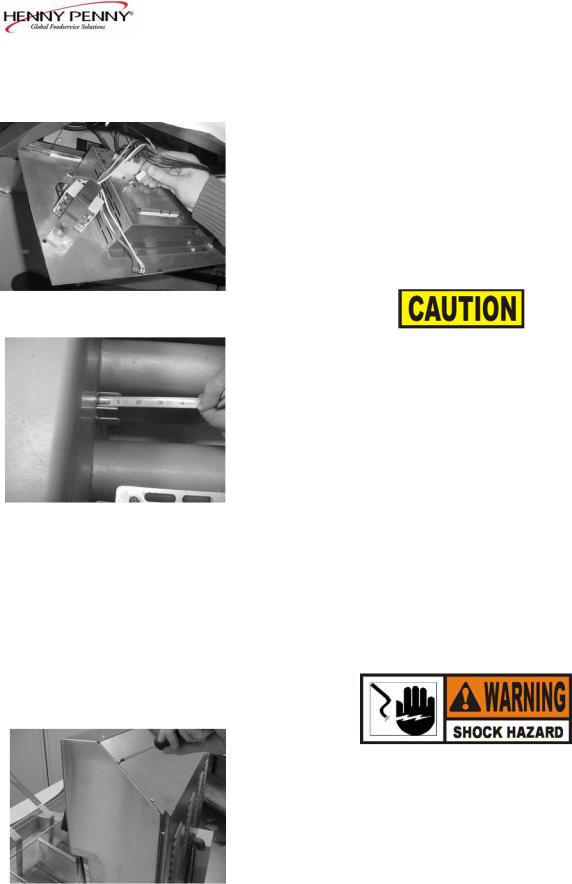
Model OFE/OFG/OEA/OGA-341, 342
2-6. TEMPERATURE PROBE REPLACEMENT (GAS) (Continued)
Figure 2-15
Figure 2-16
5.Remove the probe from the frypot, and disconnect wire connector from the control panel. Figure 2-15.
6.Place the nut and new ferrule on the new probe and insert the probe into the compression fitting until it extends one (1) inch (2.54cm) into the frypot. Figure 2-16.
7.Tighten hand tight and then a half turn with wrench.
Excess force will damage probe.
8.Connect new probe to PC board and replace control panel.
9.Replace shortening, and turn power on to check out fryer.
2-7. TEMPERATURE PROBE |
|
The temperature probe relays the actual shortening temperature |
REPLACEMENT (Gas) |
|
to the control board. If it becomes disabled, “E06” shows in the |
REPLACEMENT |
|
display. Also, if the shortening temperature is out of calibration |
(ELECTRIC) |
|
more than 10°F or C°, the probe should be replaced. An Ohm check |
|
|
can also be performed. See chart on page 2-5. |
|
1. |
Remove electrical power supplied to the fryer. |
|
|
To avoid electrical shock or property damage, move the |
|
|
power switch to OFF and disconnect main circuit |
|
|
breaker, or unplug cord at wall receptacle. |
|
2. |
Drain the shortening from the frypot. |
Figure 2-17 |
3. |
Remove screws securing rear cover of fryer, and remove rear |
|
|
cover. Figure 2-17. |
2-6 |
|
1209 |
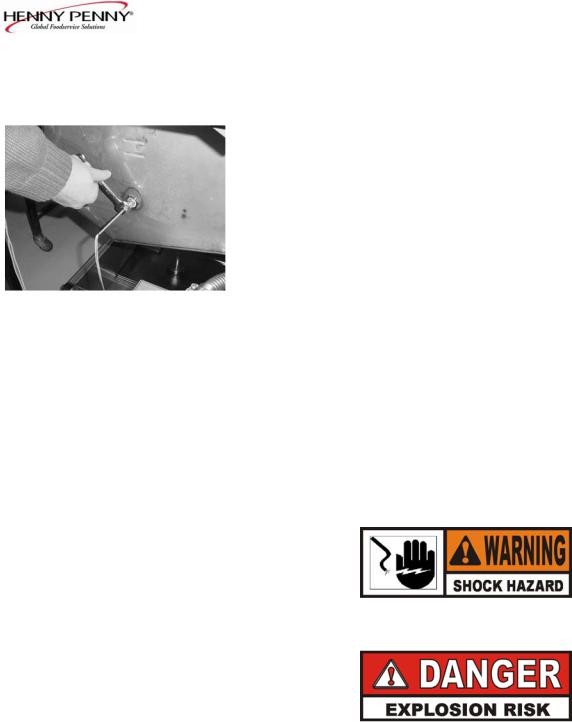
Model OFE/OFG/OEA/OGA-341, 342
2-7. TEMPERATURE PROBE REPLACEMENT (ELECTRIC) (Continued)
Figure 2-18
2-8. FLAME SENSOR/ PILOT / IGNITOR ASSEMBLY (GAS)
4.Using a ½ inch wrench, remove the nut on the compression fitting. Figure 2-18.
5.Remove the probe from the frypot, and disconnect probe.
6.Place the nut and new ferrule on the new probe and insert the probe into the compression fitting until it extends one (1) inch (2.54cm) into the frypot.
7.Reconnect new probe onto wires, replace rear cover, and fryer is now ready for use.
The Henny Penny open fryer (gas) has electronic spark ignition that lights a standing pilot. The gap between the spark electrode and the pilot hood should be1/8 of an inch (3.18 mm). The
flame sensor recognizes the pilot flame and allows gas to continue to the pilot. The flame sensor must send a minimum of two (2) micro amps to the ignition module. The pilot flame should be split in two by the flame sensor, causing the flame sensor to be bright red in color.
1.Remove electrical power supplied to the unit.
To avoid electrical shock or property damage, move the power switch to OFF and disconnect main circuit breaker, or unplug cord at wall receptacle.
TO AVOID PERSONAL INJURY OR PROPERTY DAMAGE, BEFORE STARTING THIS PROCEDURE, MOVE THE MAIN POWER SWITCH TO THE OFF POSITION. DISCONNECT THE MAIN CIRCUIT BREAKERS AT THE CIRCUIT BREAKER BOX OR UNPLUG SERVICE CORD FROM WALL RECEPTACLE. TURN OFF THE MAIN GAS SUPPLY TO THE FRYER AND DISCONNECT AND CAP THE MAIN SUPPLY LINE TO FRYER, OR POSSIBLE EXPLOSION COULD RESULT.
1003 |
2-7 |

Model OFE/OFG/OEA/OGA-341, 342
2-8. FLAME SENSOR/ PILOT / IGNITOR ASSEMBLY (Gas) (Continued)
2.Remove the control panel and heat shield from control area. Figure 2-19.
Figure 2-19
3.Disconnect the flame sense wire from ignition module. Figure 2-20.
Figure 2-20
4.Using a 7/16” wrench, loosen the nut on the pilot tube and pull tube from assembly. Figure 2-21.
Figure 2-21
5.Remove the two screws securing the assembly and pull assembly from unit. Figure 2-22.
6.Now the flame sensor or or pilot assembly can be removed from bracket.
Figure 2-22
2-8 |
1003 |
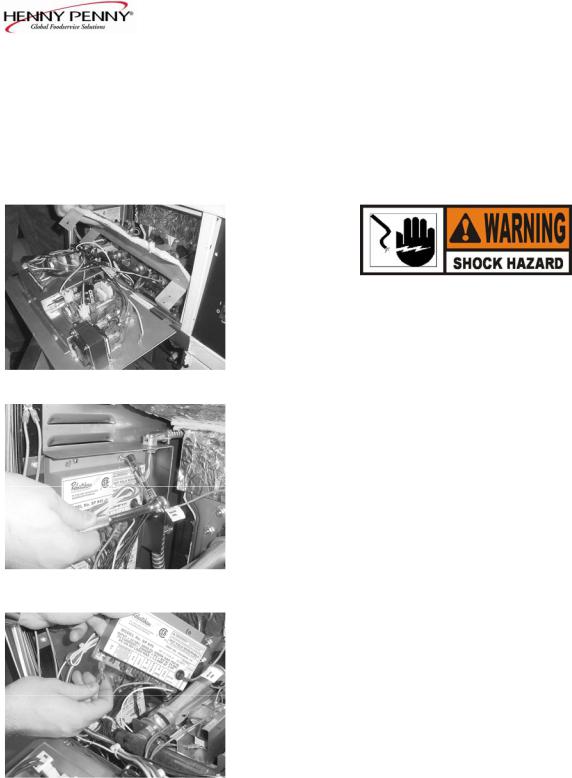
Model OFE/OFG/OEA/OGA-341, 342
2-9. IGNITION MODULE During normal operation, the ignition modules send 24 volts to the ignitors and gas valve. If a module does not sense a pilot flame, the module starts the ignition process again. But, if a pilot light goes out for longer that 10 seconds, or it goes out 3 times within 10 seconds, the module keeps the 24 volts from reaching the gas valve. The burners shut down.
1. Remove electrical power supplied to the unit.
|
To avoid electrical shock or property damage, move the |
|
power switch to OFF and disconnect main circuit |
|
breaker, or unplug cord at wall receptacle. |
Figure 2-23 |
2. Remove the control panel and heat shield from control area. |
|
Figure 2-23. |
3.Using a 3/8 inch socket, remove the two nuts securing the module. Figure 2-24.
Figure 2-24
4.Label and remove the wires at module. Figure 2-25.
5.Install new module in reverse order.
Figure 2-25
1003 |
2-9 |
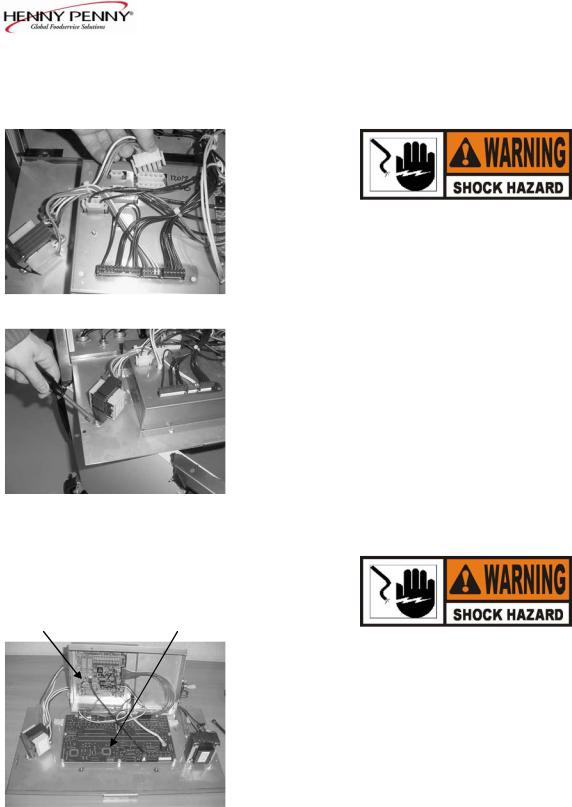
|
|
|
Model OFE/OFG/OEA/OGA-341, 342 |
2-10. TRANSFORMER |
The transformer reduces voltage down (to 24V) to accommodate |
||
REPLACEMENT |
those components with low voltage. |
||
|
|
1. |
Remove electrical power supplied to the unit. |
|
|
|
To avoid electrical shock or property damage, move the |
|
|
|
power switch to OFF and disconnect main circuit |
|
|
|
breaker, or unplug cord at wall receptacle. |
Figure 2-26 |
|
2. |
Remove the control panel |
|
|
|
|
|
|
3. |
Remove the two wire connectors to disconnect transformer |
|
|
|
From panel. Figure 2-26. |
|
|
4. |
Using a 3/8” nut-driver, remove the two nuts securing the |
|
|
|
transformer to the panel and remove transformer. Figure 2-27. |
Figure 2-27 |
|
5. |
Install the new transformer in reverse order. |
|
|
|
|
2-11. CONTROL & I/O |
1. |
Remove electrical power supplied to the unit. |
|
BOARDS |
|
|
|
REPLACEMENT |
|
|
|
I/O Power Supply |
Control |
|
To avoid electrical shock or property damage, move the |
|
|
|
|
|
|
|
power switch to OFF and disconnect main circuit |
|
|
|
breaker, or unplug cord at wall receptacle. |
|
|
2. |
Remove the control. |
|
|
3. |
Using a 5/16” nut-driver or wrench, remove the 4 nuts securing |
|
|
|
the PC shield and remove shield. Figure 2-28. |
Figure 2-28 |
|
4. |
Disconnect the wire assemblies from the appropriate board. |
|
5. |
Using a 5/16” nut-driver or wrench, remove the 4 nuts securing |
|
|
|
||
|
|
|
the appropriate board to the shroud. |
|
|
6. |
Install the new board in reverse order. |
2-10 |
|
|
1003 |
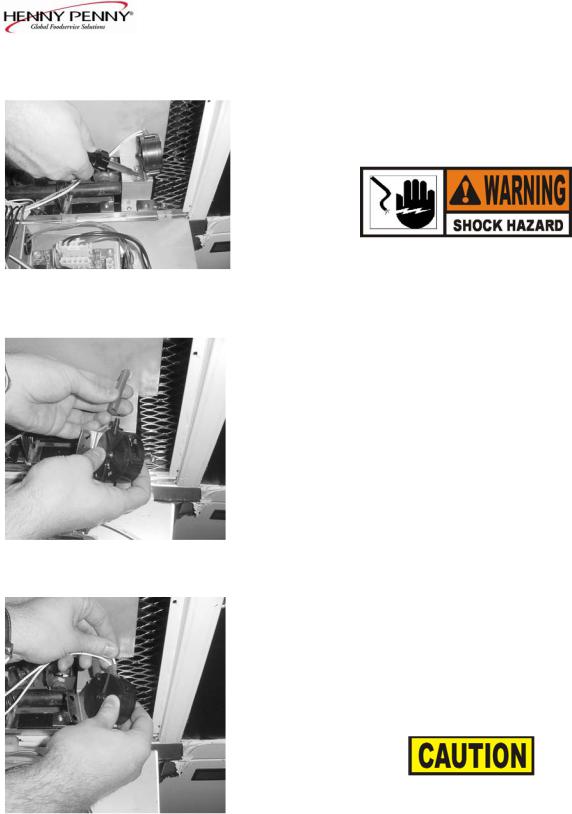
Model OFE/OFG/OEA/OGA-341, 342
2-12. VACUUM SWITCHThis switch senses the airflow from the induction blower. If REPLACEMENT the airflow is reduced below a set amount, the switch opens and
the I/O board cuts power to the gas control valve, which shuts the pilot flame off.
1. Remove electrical power supplied to the unit.
|
To avoid electrical shock or property damage, move the |
|
power switch to OFF and disconnect main circuit |
Figure 2-29 |
breaker, or unplug cord at wall receptacle. |
2. |
Remove the control panel. |
3. |
Remove the 2 screws securing the switch to the heat shield. |
|
Figure 2-29. |
4. |
Remove the air hose from the air switch. Figure 2-30. |
Figure 2-30 |
|
5. |
Label and remove wires from air switch. Figure 2-31. |
6. |
Install new vacuum switch in reverse order. |
|
To avoid property damage, do not tamper with, or disassemble |
Figure 2-31 |
this component. It is set and sealed from the factory and is not |
to be adjusted. |
1003 |
2-11 |
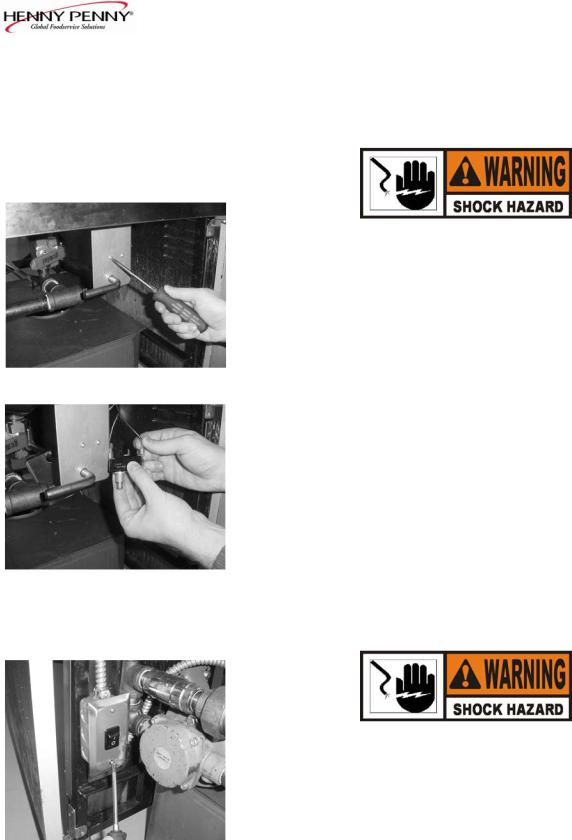
Model OFE/OFG/OEA/OGA-341, 342
2-13. DRAIN MICROSWITCH Upon turning the drain handle, the drain microswitch should REPLACEMENT “open”, cutting off the pilot flame. This will prevent the fryer
from heating while shortening is being drained from the frypot.
1.Remove electrical power supplied to the unit.
To avoid electrical shock or property damage, move the power switch to OFF and disconnect main circuit breaker, or unplug cord at wall receptacle.
2.The following check should be made to determine if the drain microswitch is defective.
a. Remove the two screws and nuts securing the microswitch Figure 2-32 to the drain rod valve bracket, and remove microswitch.
Figure 2-32.
b.Remove wires from the switch. Figure 2-33.
c.Check for continuity across the two outside terminals of the drain switch. If the circuit is open, the drain switch is defective. The circuit opens by pressing on the actuator of the microswitch.
3.If defective, replace switch in reverse order.
Figure 2-33
2-14. FILTER SWITCH |
|
REPLACEMENT |
1. Remove electrical power supplied to the unit. |
To avoid electrical shock or property damage, move the power switch to OFF and disconnect main circuit
breaker, or unplug cord at wall receptacle.
Figure 2-34 |
2. Open the door (left door on 2 well units), and remove the 2 |
screws securing the switch box cover. Figure 2-34. |
2-12 |
1003 |
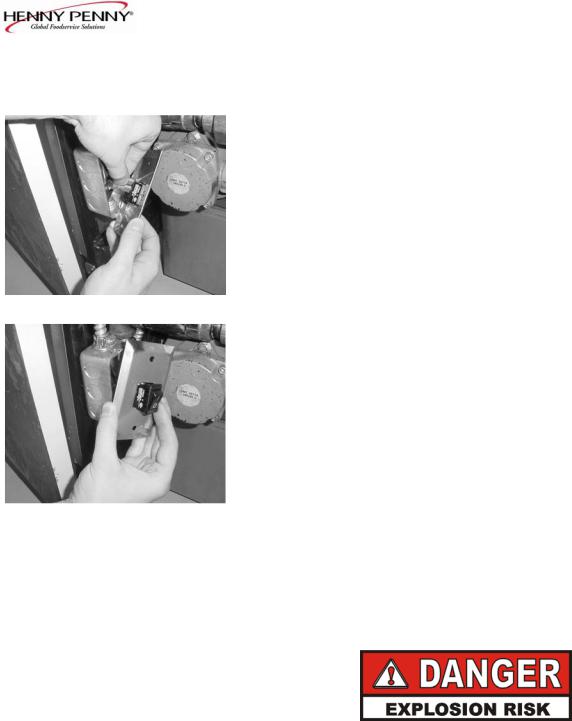
|
Model OFE/OFG/OEA/OGA-341, 342 |
2-14. FILTER SWITCH |
3. Label and remove the wires from the switch. With test |
REPLACEMENT |
instrument check across the terminals of the switch. With the |
(Continued) |
switch in the on position, the circuit should be closed. With the |
|
switch in the off position, the circuit should be open. If the |
|
switch is defective, replace by continuing with this |
|
procedure. Figure 2-35. |
Figure 2-35
4.With wires removed from the switch, push in on tabs on the switch and remove switch from front of switch box cover. Figure 2-36.
5.Push new switch into panel and reconnect wires.
Figure 2-36
2-15. GAS CONTROL VALVE The gas valve assembly controls the flow of gas to the pilot and the REPLACEMENT main burner. The valve has two 24-volt coils, which are regulated
by the P and M terminals on the valve. The C terminal is the common terminal. For gas flow to the pilot, 24 VAC must be present between the P and C terminals. For gas flow to the main burner, 24 VAC must be present between the M and C terminals.
TO AVOID PERSONAL INJURY OR PROPERTY
DAMAGE, BEFORE STARTING THIS
PROCEDURE, MOVE THE MAIN POWER SWITCH
TO THE OFF POSITION. DISCONNECT THE MAIN
CIRCUIT BREAKERS AT THE CIRCUIT BREAKER
BOX OR UNPLUG SERVICE CORD FROM WALL
RECEPTACLE. TURN OFF THE MAIN GAS
SUPPLY TO THE FRYER AND DISCONNECT AND
CAP THE MAIN SUPPLY LINE TO FRYER, OR
POSSIBLE EXPLOSION COULD RESULT.
1003 |
2-13 |

Model OFE/OFG/OEA/OGA-341, 342
2-15. GAS CONTROL VALVE
REPLACEMENT (Continued)
1. Remove right side panel. Figure 2-37.
Figure 2-37
2. Label and remove wires from gas valve. Figure 2-38
Figure 2-38
3.Using a 7/16 wrench, remove the pilot line from the gas valve. Figure 2-39.
Figure 2-39
4.Using a 1-inch wrench, loosen the nut securing the main gas inlet line to the gas valve. Figure 2-40.
Figure 2-40
2-14 |
1003 |
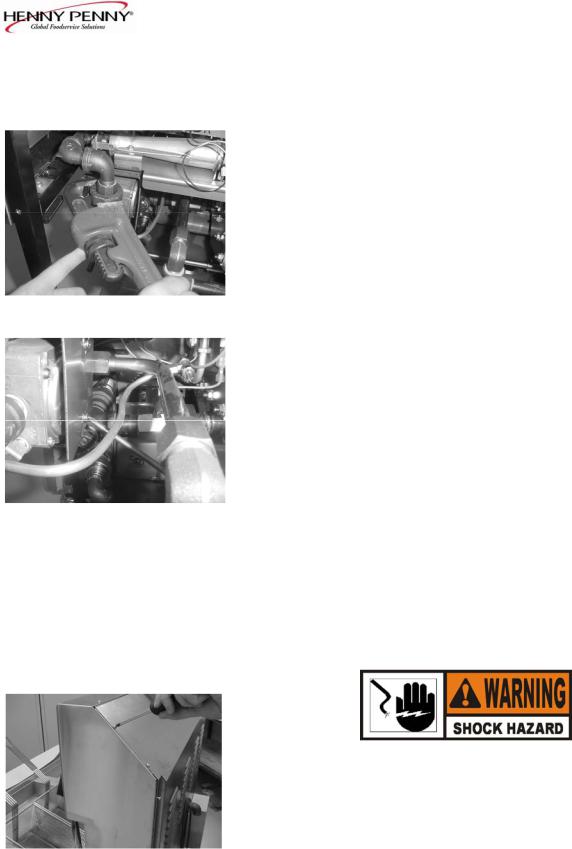
Model OFE/OFG/OEA/OGA-341, 342
2-15. GAS CONTROL VALVE
REPLACEMENT (Continued)
5.Using a pipe wrench, loosen the outlet fitting to the burner. Figure 2-41.
Figure 2-41
6.Using a Phillips screwdriver, remove the 2 screws securing the gas valve to the bracket and remove gas valve from unit. Figure 2-42.
7.Remove the fittings from the gas valve and install in new gas valve.
Figure 2-42
8. Install the new gas valve in reverse order.
2-16. BLOWER MOTOR The blower motor assembly induces the draft for the burners. If the REPLACEMENT blower motor fails, the air switch will fail to close, causing an
“E-20B” error code in the display.
1. |
Remove electrical power supplied to the unit. |
|
To avoid electrical shock or property damage, move the |
|
power switch to OFF and disconnect main circuit |
|
breaker, or unplug cord at wall receptacle. |
2. |
Remove screws securing the rear cover to the unit. |
Figure 2-43 |
Figure 2-43. |
106 |
2-15 |
